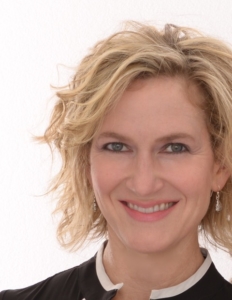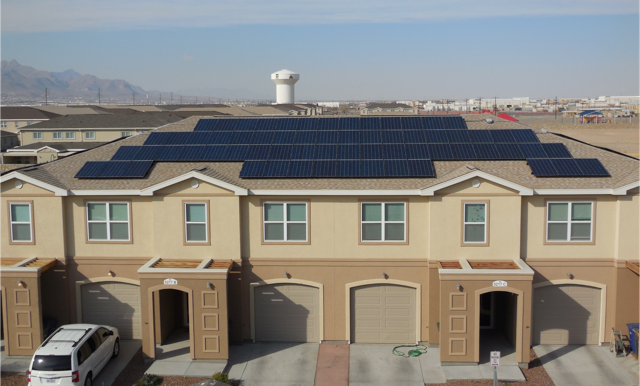 This interview was the first case study highlighted in HeatSpring Magazine’s Sustainable Women Series, June 2016.
This interview was the first case study highlighted in HeatSpring Magazine’s Sustainable Women Series, June 2016.
What does it take to build a 75% net zero community and the “largest Emerald-rated community” in the world? Tabitha Crawford explains how her team combined solar, HVAC, and sustainable building practices to build 250 net zero homes while keeping construction costs at a 3% premium.
Q: Tell us about your Emerald-rated Community:
Our community is a 250 new multi-family home development on Fort Bliss (near El Paso) Texas. That makes it the largest Emerald-rated community in the world.
We were able to focus on high “bang for the buck” change outs of higher efficiency products, allowing us to build the near net zero homes at only a 3% construction cost premium. Many companies think it will cost too much to build super efficient homes, but it is much less costly now as sustainable products and renewable energy costs have declined significantly in the last three years.
The entire community at Fort Bliss has a 13.4 MW rooftop solar array on over 4,700 homes. It offsets about 26% of the grid-powered electricity demand for the Fort Bliss community. The community is 75% net zero and operates 60% above international energy efficiency codes.
Q: What does it mean for a community to attain “Emerald rating”?
Emerald and Gold homes use 50-60% less energy than most municipal codes specify.
According to the National Association of Home Builders (NAHB):
The ICC/ASHRAE 700-2015 National Green Building Standard™ (NGBS) is the first residential green building standard to undergo the full consensus process and receive approval from the American National Standards Institute (ANSI).
First developed in 2008, NAHB, the International Code Council (ICC) andASHRAE have partnered to develop the third edition of the nationally recognized standard, which is expected to be approved and published in early 2016. To date, the standard has been widely implemented throughout the industry. The Home Innovation Research Lab has certified the compliance of more than 50,000 dwelling units. Dozens of regional and local green initiatives refer to the standard within their program criteria and the International Green Construction Code (IgCC) allows compliance with ICC 700 NGBS as an alternate compliance path for residential buildings more than four stories in height.
Q: You reported a 3% construction cost premium for the project. What did this include and how did you keep it so low?
Balfour Beatty Communities & Balfour Beatty Construction already build homes to LEED Gold v.2009 standards, so products specified were already energy efficient. The teams also consulted government websites such as EnergyStar and WaterSense to get recommendations on products.
For NGBS, product specification had to meet a 5-year payback to be included and it was ultimately up to the owner, BB Communities, and the Army to approve products.
- General Electric hybrid electric hot water heaters
- Dual-flush 1.1 & 1.6 gallons per flush toilets
- CEE Tier 3 Whirlpool refrigerator – most energy efficient
- Triple pane low-e argon glass
- Tyvek commercial wrap (in lieu of home wrap)
- Blow-in open cell insulation R-15 in walls
- Combo batt/blow-in R-38 in attic and garage ceiling
We also used 16 SEER 3.0 ton HVAC systems.
Q: What were the net zero cost savings for homeowners?
At a $0.07 cost/kWh of electricity, $383/year was saved per home. That’s $95,000/year saved for all 250 homes. That’s 5,200+ kWh savings/year per home and 1,300,000 kWh savings/year all homes.
Q: What was the most challenging aspect of the project?
Because the project is of a design/build structure, we as the designers/builders had to really educate ourselves on the products that we would be using and how they might affect the building structure and the systems as a whole. For example, one major concern was that we might be making the building envelope too tight. We switched to the spray foam insulation, and really made an effort to close air gaps throughout the structure in order to meet the blower door testing, or envelope testing. We had to work with the engineers, and really study the climate to determine if any air change cycling issues or mold issues might arise. Because we’re in the desert, mold isn’t an issue, but we did made some tweaks to make sure we were getting the fresh air intake we needed for the mechanical systems.
Q: What was the most rewarding aspect of the project?
Sharing the lessons learned and the value of sustainable building. Our Army partner at Fort Bliss & Balfour Beatty Communities helps military families by building green to reduce operating costs, increase energy security and enhance current communities on base by designating them “sustainable communities.”
Q: Tell us a bit about your career path. How did you end up in this line of work?
 My education is in finance with a master’s in bank management and an MBA. I started out building electronic payment systems for a small Kentucky-based company and have always worked on creating new programs and change-management types of services. “Sustainability” is appealing to me because I believe a focus on solutions that are positive for both the environment and for businesses would create stronger communities while remaining profitable.
My education is in finance with a master’s in bank management and an MBA. I started out building electronic payment systems for a small Kentucky-based company and have always worked on creating new programs and change-management types of services. “Sustainability” is appealing to me because I believe a focus on solutions that are positive for both the environment and for businesses would create stronger communities while remaining profitable.
Having a financial background, it has been tremendously helpful to pose “sustainable” projects in terms of deal economics rather than altruism. People will change or take a risk if there’s a financial reward much more quickly than if something is good for the environment (short- versus long-term rewards). Creative financial models, like our third-party ownership structure of the solar at Fort Bliss, have allowed us to accelerate the adoption of renewable energy. I remain in this line of work, despite dropping gasoline and natural gas prices, because I’m passionate about making decisions that allow us to meet needs today without compromising the health of plants and animals around us (not to mention humans!)


